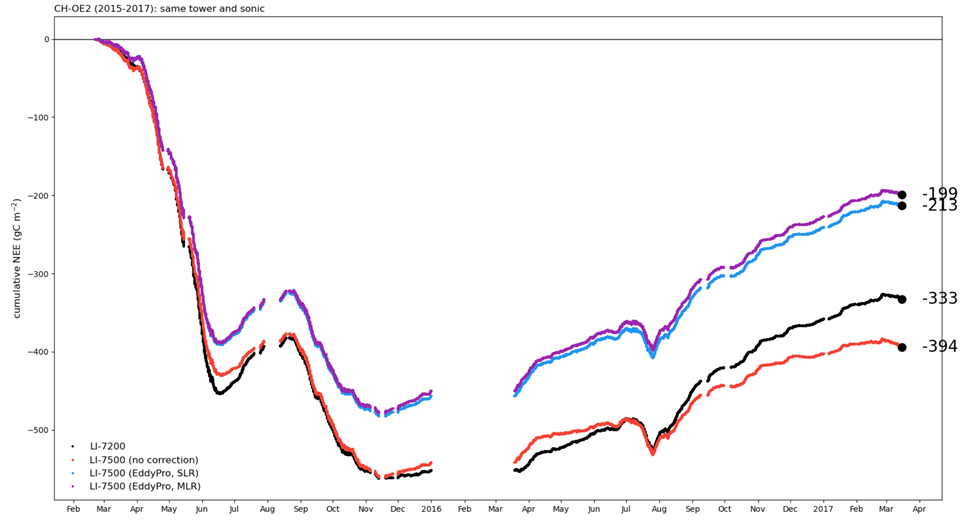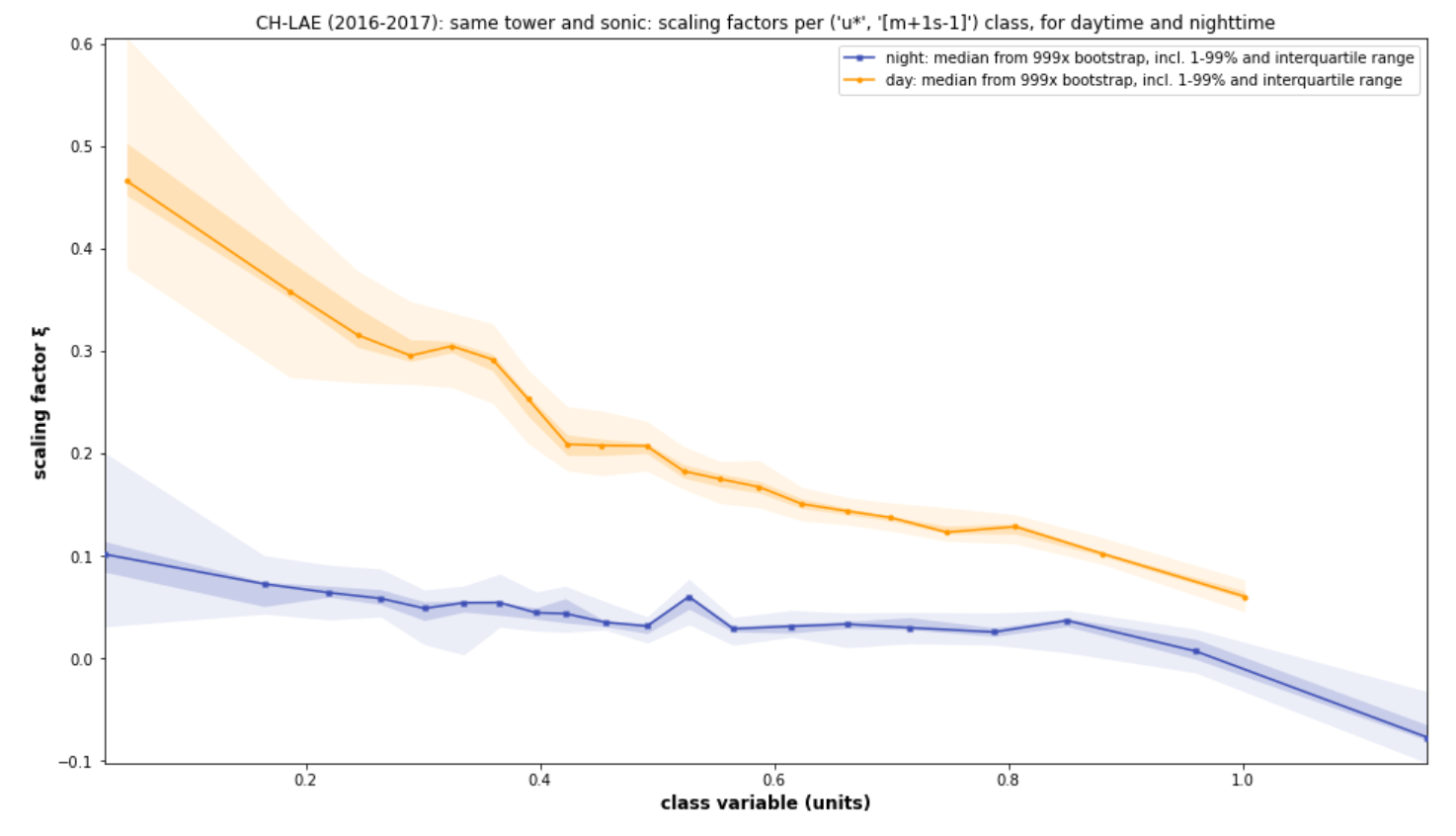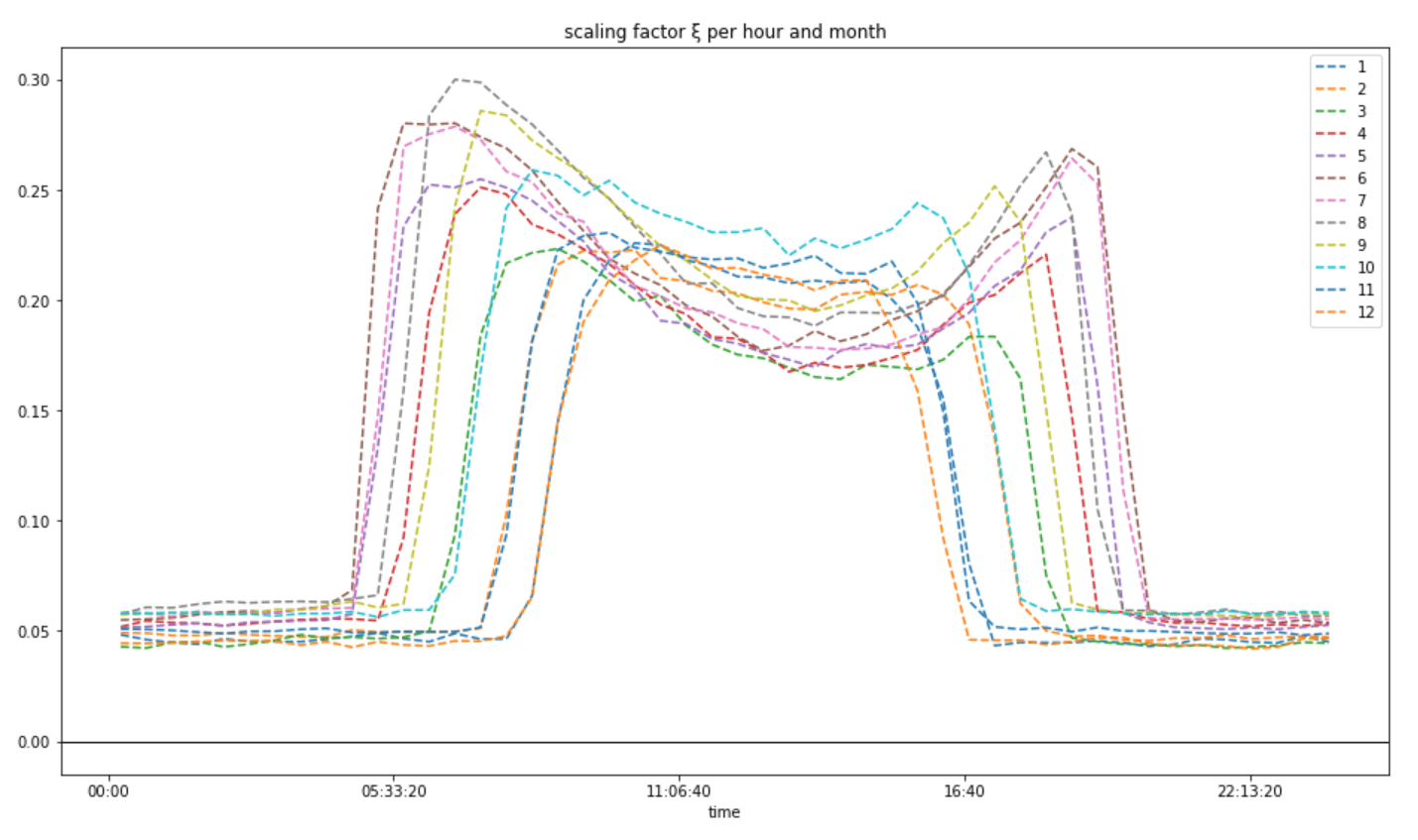Supplementary Information#
Instrument sensible heat components for LI-7500#
No self-heating correction was applied to open-path IRGA fluxes.
General issue#
The application of the self-heating correction without concurrent parallel measurements with a (en-)closed path IRGA at the same site is risky because it would constitute a “blackbox” approach, i.e., we cannot know the validity of the correction. The correction is originally meant for cold ecosystems and there in particular for time periods with air temperatures < -10°C, which is rarely the case at CH-CHA. From the EddyPro help (this was from an older version):
“When CO2 and H2O molar densities are measured with the an LI‑7500 in cold environments (low temperatures below -10 °C), a correction should be applied to account for the additional instrument-related sensible heat flux, due to instrument surface heating/cooling.”
In addition, the correction by Burba et al. (2008) considers vertically mounted IRGAs only, while the IRGA at CH-CHA (and all other Swiss FluxNet sites) are tilted at approx. 15°. The correction does not account for this tilting angle.
We are therefore hesitant in applying this correction for CH-CHA because we found that the correction was not working as expected for other site in Swiss FluxNet. For example, the cropland CH-OE2 (link) is at 452 m a.s.l. and climatic conditions (air temperatures) are very similar to CH-CHA. For CH-OE2, we had the option to compare fluxes from the open-path IRGA LI-7500 (LI75) with concurrent fluxes from the enclosed-path IRGA LI-7200 (LI72). We found that LI75 and LI72 fluxes corresponded relatively well over approx. 2 years (figure, LI75 in red, LI72 as “true” flux in black). However, when we corrected the LI75 fluxes using EddyPro (Burba 2008 method) we found that the correction resulted in a strong underestimation of the cumulative carbon uptake in comparison to LI72 (see blue and purple lines in figure). This indicates that the default application of the Burba 2008 correction is risky.

Fig. 6 Cumulative NEE fluxes from Feb 2015 until Apr 2017 at the cropland site CH-OE2. Shown is a comparison of self-heating correction approaches: open-path LI-7500 fluxes (only WPL corrected, red) with enclosed-path LI-7200 fluxes (black, assumed to show the “true” flux). Also shown are cumulative fluxes after applying the Burba 2008 correction in EddyPro using the single linear regression method (SLR, blue) and the multiple regression method (MLR, purple).#
In contrast, for the forest site CH-LAE (link) we found that some self-heating correction is clearly needed, even in summer when temperature increase > 30°C. Here, the Burba 2008 correction yields unsatisfactory results and corrects the fluxes only slightly, albeit in the right direction (figure). CH-LAE has a relatively unique location and is very different from CH-CHA. For CH-LAE, we apply the self-heating correction similar to Kittler et al. (2017, link), which used an earlier description of the correction (Burba 2006) in combination with a scaling factor. A more detailed description for the CH-LAE correction can be found here: link. Unfortunately, at CH-CHA we cannot apply this method since parallel measurements are not available.

Fig. 7 Cumulative NEE between Jan 2016 and Dec 2017 at the forest site CH-LAE. “True” flux from LI-7200 (black), no self-heating correction for LI-7500 fluxes (red), after correction in EddyPro Burba 2008 (blue) and after correction Kittler 2017 (orange).#
The self-heating issue for open-path IRGAs is still not solved. Due to the reasons outlined above and the involved uncertainties we currently refrain from applying the correction to CH-CHA fluxes.
Details#
Without parallel measurements it is not possible to quantify the uncertainty related to IRGA self-heating. The correction proposed by Burba et al. (2008) was developed based on a relatively short dataset from few sites with vertically-mounted IRGAs. Applying this correction to data from the inclined-mounted IRGA from CH-CHA would need knowledge about the fraction (ξ, scaling term) of the correction that is needed at this specific site. The fraction must be determined empirically and can range from 0 (no self-heating effect) to 1 (full self-heating correction). Examples for the empirically detected fraction term are e.g. 0.05 for grasslands (Rogiers et al., 2008) and e.g. 0.06 for urban, 0.085 for forest environments (Järvi et al., 2009). It was previously reported that ξ can be extremely small (0.005 – 0.015) even for arctic ecosystems where ξ is expected to be higher than in moderate climates (Holl et al., 2019). Kittler et al. (2017) showed that different ξ values are needed for daytime and nighttime data (empirically determined from parallel measurements). Our own research into this issue revealed an even more complex picture: we found that ξ, determined from parallel measurements, can vary significantly over the course of one day.

Fig. 8 shows ξ for the forest site CH-LAE and demonstrates that ξ is mostly 0.05 during the night (i.e. the night fluxes need a 5% self-heating correction), but increases during sunrise, reaching values of up to 0.3. In contrast, ξ for the forest site CH-DAV showed a completely different picture.#

Fig. 9 shows that for the forest site CH-LAE, high values for ξ are needed during the day, but ξ is close to zero during the night (i.e. nighttime fluxes need little correction).#
The central finding of_ this figure and_ this figure is that ξ is not constant and applying an unknown constant ξ to fluxes where parallel measurements were not available would yield “corrected” fluxes of unknown quality. In the absence of parallel measurements, ξ remains unknown. Unfortunately, there is no general ξ value that can be used with confidence across sites or for specific ecosystems. A recent study recommended against applying the fitting correction with coefficients for other sites (Deventer et al., 2021).
It was shown previously that the self-heating effect can be negligible at grasslands (e.g. Haslwanter et al, 2009, see their Fig. 2; AT-Neu) and that the self-heating correction can produce fluxes that are far away from the “true” flux (Wohlfahrt et al, 2008, see their Fig. 3). The observation that the correction can produce fluxes that are worse than uncorrected fluxes is in line with our observations: we already showed above how a blackbox application of the correction can produce fluxes that are far away from the “true” flux from a closed-path system at our cropland site CH-OE2.
Due to the points raised we – and many other sites using the LI-COR LI-7500 – are currently not in a position to determine the flux uncertainty due to IRGA self-heating, which is unfortunate. A blackbox application of available corrections is risky, as the study by Deventer et al. (2021) points out: the use of current self-heating corrections in the absence of parallel reference flux measurements “[…] yields uncertainties that are larger than random flux errors—substantially degrading confidence in ecosystem carbon[…]budgets”.
